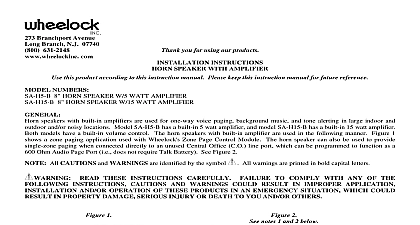Wheelock Designing for Intelligibility white paper by Eaton

File Preview
Click below to download for free
Click below to download for free
File Data
| Name | wheelock-designing-for-intelligibility-white-paper-by-eaton-2170984536.pdf |
|---|---|
| Type | |
| Size | 1.63 MB |
| Downloads |
Text Preview
Thought leadership paper for Intelligibility vs Audibility summary catastrophic natural disasters to the threats college face there has been a heightened demand for mass systems MNS to provide clear concise and voice messages that communicate how people respond in an emergency Man made or natural the and diversity of today threats have influenced the government and other organizations to create regulatory for mass notification and emergency communication including voice intelligibility requirements for these safety systems to be effective International European North American fire alarm codes now require that evacuation systems meet minimum levels of speech of MNS 1996 terrorists attacked Khobar Towers a U S Air Force housing complex in Dhahran Saudi Arabia killing 19 U S and wounding hundreds of others Secretary of William Cohen issued a post incident report of the attack concluded that there was no effective notification system with to warn personnel The principal means for sounding an alarm Khobar Towers consisted of having personnel go from door to door an eight story dormitory alerting residents of the danger primitive approach prompted the U S Military to develop force standards Thus in 1999 the US Air Force developed the Force Protection Standards In 2002 the Department Defense DoD created the Unified Facilities Criteria UFC 4 010 Minimum Antiterrorism Standards for Buildings where mass was first defined Two years later the DoD published the 04 021 01 Design and O M Mass Notification Systems which the installation of intelligible voice notification systems in around new inhabited buildings in DoD facilities creating the UFC the DoD discovered that most fire alarm were unable to communicate with people in non fire such as severe weather The US Air Force petitioned National Fire Protection Association NFPA to develop MNS As a result the NFPA added Annex E Mass Systems as recommended guidelines for MNS in the Fire Alarm Code 2007 edition the NFPA 72 Fire Alarm and Signaling Code 2010 Annex E became Chapter 24 Emergency Communications ECS the first mass notification code for the private This edition included requirements for intelligibility In 2010 Laboratories UL moved towards establishing a new for mass notification UL 2572 Ratified in 2011 UL 2572 how a mass notification system performs against the ECS codes to the focus on MNS the 1999 edition of NFPA 72 the first definition of voice intelligibility and added that communication systems must have messages with intelligibility However most of the information was placed the Annex as guidelines with references to IEC standards quantitative measurement approaches In the 2007 edition was referenced in more locations and when Annex E on was added it generated renewed focus on intelligibility system that produces a high level of audibility does not mean that is intelligible Basically if a voice message cannot be understood building occupants then the ECS has failed and may have caused harm than good Listening to an unintelligible voice message like driving with no headlights in the dark You have no idea where are going Therefore it is important to understand how to plan design and measure intelligibility for each installation on factors that affect intelligibility and which spaces require it leads to the next definition to NFPA 72 2010 and an important term to understand when for intelligibility is Acoustically Distinguishable Space Defined by NFPA an ADS is an emergency communications zone subdivision physically defined space or section of a that might be distinguished from other spaces because of acoustical environmental or use characteristics such as sound pressure level An ADS is an area that has the same properties as multiple rooms spaces which have the same height as well as the same walls ceiling and floor treatments a room has different acoustic properties in different areas the become multiple ADS All parts of a building intended to have notification are subdivided in ADS As determined by the designer during the planning and design phase of the ECS ADS must be identified as either requiring intelligibility or not intelligibility According to NFPA an ADS that differs from space because of frequency and level of ambient noise require speakers and system components that have a wider bandwidth such as the Wheelock Eluxa Exceder LED3 EH high fidelity speaker lines for 2013 include new sections that require system to identify and document which locations will have audible and intelligibility and which spaces will not There were reasons for the addition The first reason is to show users that may be areas where audible notification will not be provided the second was to set up documentation requirements In the Code states where required by AHJ or codes ADS and plans must be submitted to AHJ for approval diagram below illustrates the steps in identifying whether ADS requires voice intelligibility Step 1 is if the ADS requires notification If yes then step 2 is whether the space audible tone only or tone alert and voice If selected voice step 3 identifies if the ADS should have intelligible voice NFPA 72 2010 the requirement for intelligibility was moved into Chapter 24 In the 2010 edition NFPA added Annex D Speech Supplement 2 Emergency Communications Systems and Application Challenges and Supplement 3 Voice for Emergency Voice Alarm Communication Systems no doubt in the 2010 edition that intelligibility is key to the of an ECS NFPA 72 2013 Chapter 14 clarified intelligibility testing Previous codes specified that where voice was required intelligibility was required to be via test methods identified in ANSI S3.2 IEC 60849 or methods acceptable to the Authority Having Jurisdiction The 2013 codes state that voice communications using and manual voice announcements must be verified as distinguishable and understandable A simple listen test a assessment is permitted by code If you can understand message being delivered it would meet the intelligibility Quantitative testing measurements for intelligibility not required by code but are permitted update in the 2016 edition of NFPA 72 is that the Code permits the use of non listed speakers in order to achieve for example in spaces such as atriums and hard surface where acoustics can be challenging many designers and system integrators speech intelligibility is a new subject Fortunately the field of speech intelligibility not new to other industries such as commercial sound Much the research on speech intelligibility metrics was born out the widespread acceptance of the telephone and the use of and radios for military communications in the early part the 20th Century For the telephone the needs of the consumer the level of quality necessary for product success Military also drove the development of ways to measure or speech intelligibility requirements for intelligibility were recently introduced to fire and life safety market Eaton has written this white paper help educate system integrators and designers on the basic of speech intelligibility how it applies to MNS NFPA terminology factors that affect intelligibility tools available to design intelligible systems and how to measure it Intelligibility and Other Key Terminology 2010 definition of intelligibility changed slightly from NFPA 2007 The 2010 code defines intelligibility as quality or of being intelligible and intelligible as of being comprehensible clear The 2007 edition defined voice as voice information that is distinguishable and the difference in the definitions may be vague what should clear is the distinction between intelligibility versus audibility are critical to providing proper instructions in an emergency building occupants but the terms are not the same Think of the and Clear and have you 5 x 5 which is military for subjective loudness and clarity measurements 5x1 is loud not clear and 1x5 is not loud but crystal clear usually measured in decibels dB dBA is the state or of being perceptible by the human ear Normal calculations fire alarm professionals


